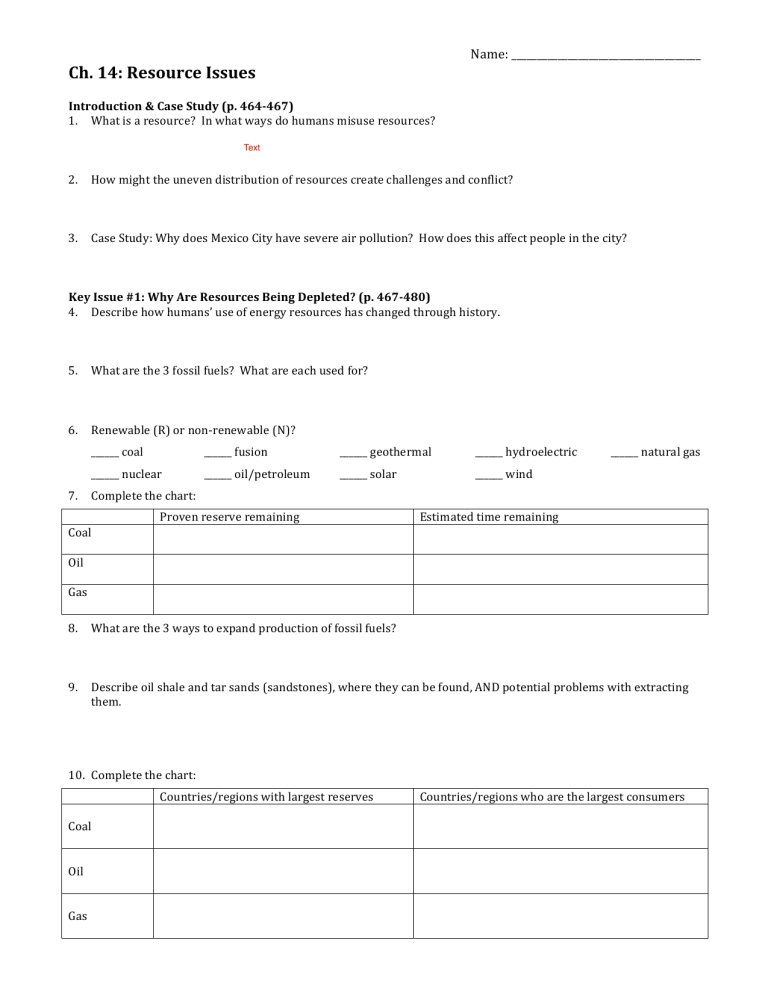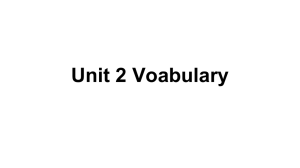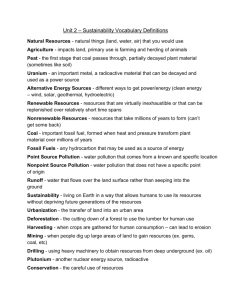
Name: _____________________________________ Ch. 14: Resource Issues Introduction & Case Study (p. 464-­‐467) 1. What is a resource? In what ways do humans misuse resources? Text 2. How might the uneven distribution of resources create challenges and conflict? 3. Case Study: Why does Mexico City have severe air pollution? How does this affect people in the city? Key Issue #1: Why Are Resources Being Depleted? (p. 467-­‐480) 4. Describe how humans’ use of energy resources has changed through history. 5. What are the 3 fossil fuels? What are each used for? 6. Renewable (R) or non-­‐renewable (N)? ______ coal ______ nuclear 7. ______ fusion ______ oil/petroleum ______ geothermal ______ hydroelectric ______ solar ______ wind ______ natural gas Complete the chart: Coal Oil Gas Proven reserve remaining Estimated time remaining 8. What are the 3 ways to expand production of fossil fuels? 9. Describe oil shale and tar sands (sandstones), where they can be found, AND potential problems with extracting them. 10. Complete the chart: Coal Oil Gas Countries/regions with largest reserves Countries/regions who are the largest consumers 11. List important OPEC countries. Why did OPEC refuse to sell petroleum in 1973-­‐74? How were MDCs forced to deal with this Energy Crisis? 12. How did the aftermath of the Energy Crisis and rising costs affect MDCs and LDCs? 13. Why did oil prices go up again in the 2000s (21st century)? 14. Describe the problems associated with coal mining and use. 15. What countries generate large amounts of nuclear energy? 16. Describe the major problems associated with nuclear energy. 17. Why do some minerals gain or lose value? Give examples. 18. Complete the chart: Nonmetallic Minerals Stone Gravel Sand Phosphorous Potassium Calcium Uses Countries Metallic minerals Uses Countries Ferrous – related to iron & its alloys (steel) Iron Manganese Chromium Titanium Magnesium Molybdenum Sulfur Nickel Nitrogen Tin Tungsten Diamonds Metallic Minerals (Nonferrous) Uses Countries Aluminum Copper Lead Zinc Silver Gold Platinum Key Issue #2: Why Are Resources Being Polluted? (p. 480-­‐488) 19. What are the most common air pollutants? What 3 human activities produce the most air pollution? 20. Describe global warming and the greenhouse effect. 21. How and why might global warming affect humans near the coasts and inland? Also, see Global Forces, Local Impacts. 22. What is the purpose of ozone? What types of pollutants affect the ozone layer? 23. What is acid deposition and acid precipitation? Why is it formed? 24. What regions and countries have been affected by acid precipitation? What damage has been caused to people and the environment? 25. What are the sources of air pollution in urban areas? What cities are the most affected and why? 26. What are the 3 main sources of water pollution? What is the difference in point-­‐source and nonpoint-­‐source pollution? Give examples. 27. Describe the impact of pollution on aquatic ecosystems. 28. How can wastewater contribute to disease? 29. Contemporary Geographic Tools: Why is the Aral Sea disappearing? What is the impact on humans and fish in the area? 30. What are sources of land pollution? How is most solid waste disposed of? 31. How is a landfill different than how humans dispose of gaseous and liquid wastes? What challenges do landfills present? 32. What are the advantages and disadvantages of incinerating trash? 33. Describe sources of hazardous waste. What problems might hazardous waste cause, such as in Love Canal, NY? Key Issue #3: Why Are Resources Reusable? (p. 488-­‐495) 34. Complete the chart: Renewable Energy Sources Biomass Hydroelectric Wind Geothermal Nuclear Fusion Solar Countries/Regions/States Advantages Disadvantages 35. What crops are used as sources of biomass fuel (ethanol)? 36. Study the picture and caption of the Three Gorges Dam on p. 490. How does this project represent the positives and negatives of hydroelectricity? 37. What is passive solar energy? Give examples. 38. Describe active solar energy. Differentiate between direct and indirect conversion. 39. What challenges exist for electric cars? 40. What products are most commonly recycled? 41. Describe how recyclables are collected. What happens once the materials are collected? 42. What common items contain recycled material? Describe challenges, if any, in recycled each of the following: paper, plastic, glass, and aluminum. 43. What strategies other than recycling can reduce pollution? 44. Describe strategies for reducing discharges. 45. How can environmental capacity be increased? Why is increasing capacity particularly challenging? Key Issue #4: Why Can Resources Be Conserved? (p. 495-­‐498) 46. Distinguish between conservation and preservation. 47. What is sustainable development? How are environmental protection and development linked? 48. Describe the 2 different criticisms of sustainability. What 1 thing do critics and defenders of sustainability agree upon? 49. What countries have the most land under conservation? What countries have no land under conservation? 50. Why are species disappearing in the tropics? What policies have promoted this destruction?




